Shadow of Mordor PS4 Review: There And Back Again
Monolith Productions invades the open-world arena with its confident and innovative tale of J.R.R. Tolkien's Middle-Earth.
This article first appeared on USgamer, a partner publication of VG247. Some content, such as this article, has been migrated to VG247 for posterity after USgamer's closure - but it has not been edited or further vetted by the VG247 team.
Original Article (09/26/2014): Normally, this is where you'd be reading my review of Shadow of Mordor. The embargo is up and everyone else's review is probably out the door. Unfortunately, things and stuff relating to shipping happened, so I'm not done with Shadow of Mordor.
One of the difficult things of reviewing games is knowing when you've played enough of a game to make a final call. When you've seen enough of the available content to write down words that'll live on some website forever. This can be an especially big problem with games that will never completely be done, like Destiny, WildStar, or Elder Scrolls Online. Luckily, Shadow of Mordor has an end. The game keeps track of your progress, so I know how close I am to that end.
From what I've played so far? Shadow of Mordor is very, very good.

In the Land of Mordor Where the Shadows Lie
Final Review: Shadow of Mordor tells the story of Talion, a Ranger of Gondor, one of many tasked with protecting the Black Gate of Mordor. Mordor, once the stomping ground of corrupt necromancer Sauron, is a far cry from the absolute hellish landscape you saw in The Lord of the Rings. Unfortunately due to the events of The Hobbit, Sauron has re-awoken and he's decided it's time to take back his home. Talion's family is killed in the conflict and the Black Hand of Sauron binds a Wraith to Talion's soul. Now he's neither dead or alive, with a p**sed-off spirit feeding him powers and a hankering for revenge.
It's not the most amazing story, but it's holding up well so far. Talion's quest for revenge is something we've seen before, so Monolith has backed it up with the additional hunt for the Wraith's backstory. He was once a very important person in Tolkien lore, but one who's never fully been characterized. Monolith gets to fill in the blanks and these discoveries make up the more interesting parts of Shadow of Mordor's plot.
The rest of the cast is full of enjoyable characters, who regardless aren't directly a part of Talion's quest. They're the side-stories in someone else's epic tales, even if their dialog crackles with wit. Gollum, cowardly Uruk Ratbag, and dwarf hunter Torvin are there to make you chuckle, while former Ranger Hirgon and warrior Lithariel represent the more serious side of Shadow of Mordor. They all weave in and out of the story, leaving brief marks on the story, not lasting impressions.
Renewed Shall Be Blade That Was Broken
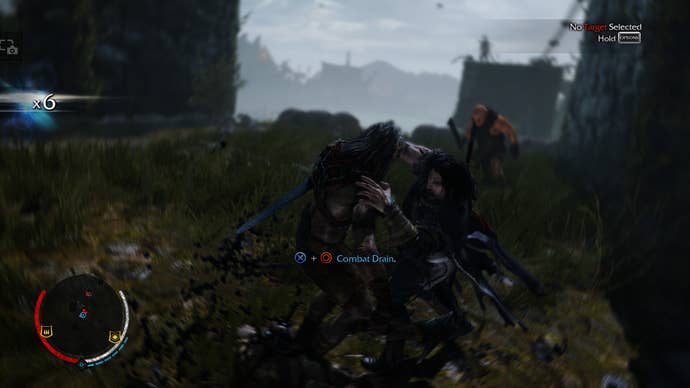
The story is a solid base, but the game shines in the play. Most people will probably compare Shadow to Assassin's Creed, but the Batman: Arkham series is an equally-apt comparison. Talion, with his Wraith-fuled abilities, is not as fragile as a human assassin and Monolith has played up that fact. Talion can do his one version of Assassin's Creed's Leap of Faith from any height without problems. He can climb and sprint just as easily; holding the Run button causes Talion to sprint and super-jump up cliffs and walls when he runs into them. Once on a wall, travel works just like Assassin's Creed, without having to hold down a button. And once you unlock the Elven Swiftness ability, you can get a boost of speed while sprinting if you hit the Run button again after leaping over an obstacle.
Talion can also dominate the dog-like Caragors or the brute Graug for a ride across the landscape. The latter isn't available until the game's second half, but the former does nicely when you need an extra boost; the Caragors are almost as agile at Talion himself. And if you unlock the Forge Towers in each region, you can fast travel at the press of a button. Monolith did everything it could to get out of players' way when it comes to getting around Mordor.
When you get into fights, Talion's combat abilities include rhythmic sword slashes, counters, dodges, stuns, and ground takedowns just like the Batman: Arkham games. Certain enemies will throw monkey wrenches into a situation, requiring dodges or stuns to take out, but that's nothing new for anyone who's played open-world games before. Most of Talion's in-combat abilities are based on the Hit Streak. Doing sucessive attacks without being hit raises the Hit Streak and at certain intervals in your streak, you'll gain access to things like Executions, the area-clearing Wraith Flash, or the quick Combat Drain move. These abilities are key to winning many battles, so it behooves you to keep your Hit Streak going.
Talion's long-range abilities are the purview of the Wraith, who brings a spirit bow to the equation. The bow can be used to kill an enemy from far away and aiming with it drops the world into a slow-motion focus. The game balances the overpowered bow - headshots from far away for the win! - by only giving you a limited number of shots. Once you're out, you have to drain more spirit arrows ("Elf Shot" in the game's parlance) from a live enemy. You can use the Focus mode to take a quick look about the battlefield or peg a headshot into a nearby foe. Later, Shadow of Mordor also adds the Shadow Strike move, which teleports Talion next to a targeted enemy; it's very good for getting around fortresses and other enemy camps.
The Wraith within also lets Talion stun enemies and interrogate them if need be. It's here that the combat bleeds into the game's most interesting feature: Sauron's Army.
The Eye of Sauron the Terrible Few Could Endure
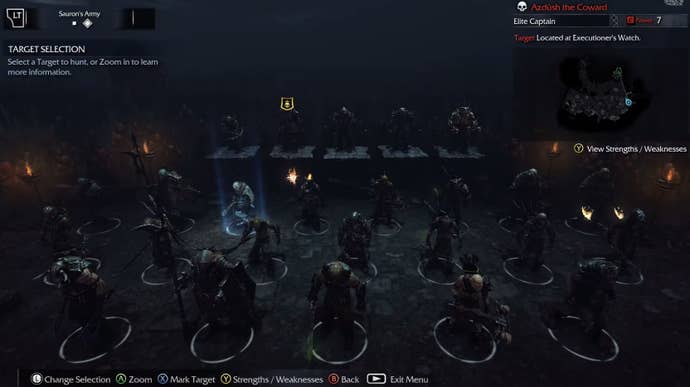
The Uruk that make up Sauron's Army are a living, breathing force that you have to deal with before you can take on the Dark Lord himself. Every single Captain and Warchief has a different name, look, and set of strengths and weaknesses. While one may fear swarms of flies, another may become enraged when its health is low. One Uruk Captain may not strike the deathblow because he doesn't find you worthy, the next may call friends to the fight, and the one after that may be so clumsy that you can throw it around with impunity. Each and every Uruk is different and they change every time you play the game through the magic of procedural generation.
This army completely shifts as you play. Each Uruk will remember you. It will remember the scars, it will remember how you defeated it, it'll remember how it killed you. Even your strategic retreats are filed away in their tiny Uruk brains. Captains will join up with Warchiefs and they'll fight amongst each other if you're not interferring. When you kill a Captain, his spot will remain empty until another is promoted in his place. If a Captain kills you, his Power will raise, meaning he'll be harder the second time around. If a grunt kills you, he'll get promoted to Captain, complete with a name and a new look.
Sauron's Army (Monolith calls it the Nemesis System) transforms Shadow of Mordor from another open-world collect-a-thon into something truly special. It's such a great idea that I'm hoping that other open-world games steal the idea. It converts Talion's world into something that feels real, even though they're just moving pieces on a chess board. You'll remember certain Uruk. A failed kill here, a misstep there, and you're dead. They'll taunt you. I mean directly: they'll look out at the screen towards the player and it feels like the game is making fun of you. Talion's revenge starts to become secondary to your own.
It's pretty damn cool.
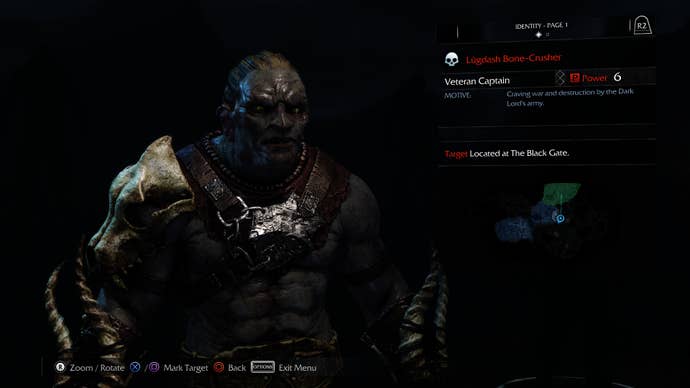
When you start the game, most of the Army is dark. You don't know who they are, their strengths and weaknesses, who they work for, or who they hate. You could just go straight at it: run in a direction until you find a Captain, kill it, and repeat the process. You can also be smart about it. Talion can use the powers of the Wraith to interrogate, and later control, the Uruk. You can ask them for information on the Captains and Warchiefs, or control them and have moles on the inside. Uruk you control can eventually become Captains on their own: you can build them up only to take them down or have your own army at your back.
You influence the Army not only by killing and controlling Uruk, but also by guiding them towards specific directions that benefit your overall objectives. Kill Captains under a Warchief to weaken it, or replace them with Captains under your control. The Uruk have their own events you can see on the map, including fights, feasts, and hunts. How you intervene in these events also contributes to the ebb and flow of Sauron's Army. All together, it changes the dynamic of Shadow of Mordor's play. Unlike an Assassin's Creed, not every target needs to die. You can kill some, others can be used directly, and still more can be subtly influenced behind the scenes. You'll put some time into thinking about how to deal with an enemy, instead of just sticking a blade in their faces.
There are problems with the Nemesis System, the chief of which is the fact that the Uruk can come back to life if you don't behead them. This means if you kill a Captain or Warchief via stealth kill or an arrow to the head, there's a chance they can return to life. If that specific Uruk was rather annoying to finish off in the first place, it may demoralize you to see them back - usually with a new scar, disfigurement, or mask to show off the last time you killed them. Sometimes I had an easier way of killing a Captain, but I had to met them in open combat so I could pull off an Execution to behead them and ensure they never return again. Sometimes, my timing was slightly off and I ended up shanking a Captain through the gut instead of executing them like I intended. Definitely frustrating at times and it undermines some of your personal choices a bit.
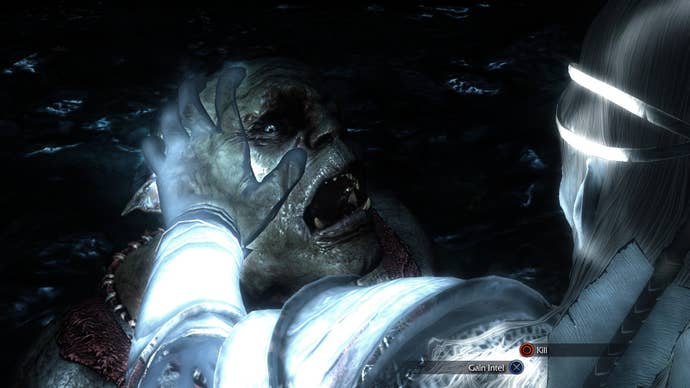
This means taking down Warchiefs can sometimes take longer than anticipated. The best way to kill a Warchief is to weaken them by killing any Captains under their thrall, but occasionally you'll kill one Captain, die trying to kill the next, only to find the first is alive again. And there's the rare moment where you're hunting one Captain, only to find three or four in the same area. That's a recipe for certain death.
There's also one major feature that the game doesn't open up until the latter half when the game shifts locations: the ability to dominate the minds of the Uruk. Yeah, you'll go through half of the game before that ability comes into play and in my case, I had already unlocked most of the other abilities available to Talion by time it came around. I understand why, because in the right hands, branding and dominating the Uruk is rather powerful, but my personal preference would've seen the ability a bit earlier. Branding isn't the only ability locked until the second half, but it's by far the one that's missed the most during the normal gameplay loop.
Despite those drawbacks, the Nemesis System creates watercooler moments for Shadow of Mordor. Stories that you can share with your friends knowing that everybody's experience is completely different. In this aspect alone, the game is a resounding success.
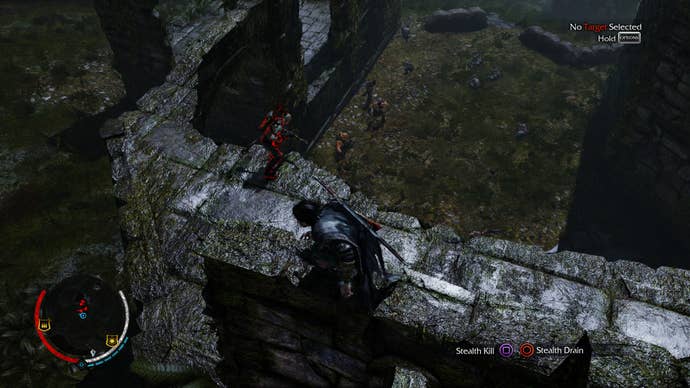
The game also backs up that combat with a decent skill system. Leveing up gives you ability points, which you can spend on things like finishing moves or new attacks and abilities. These abilities are gated in tiers by Power, which you'll gain by taking down Captains and Warchiefs, or ending Power Struggles amongst the Uruk. You can also improve Talion's attributes and unlock Rune slots on his weapons by spending Mirian, a currency you get by finishing missions or completing Challenges.
Finally, Runes are found on the corpses of Captains and Warchiefs, and come in different levels depending on how hard your foe was to kill. Runes can be equipped on your weapon to provide specific benefits. these benefits include more offensive or defense capabilities, or additional effects to specific attacks. Suffice it to say, my current Talion is far more of murder machine than he was when I first started. That said, Shadow of Mordor is keen on making you feel powerful from the beginning. Doing the Assassin's Creed-style Leap of Faith onto hard stone and then standing up? Too cool.
All That is Gold Does Not Glitter
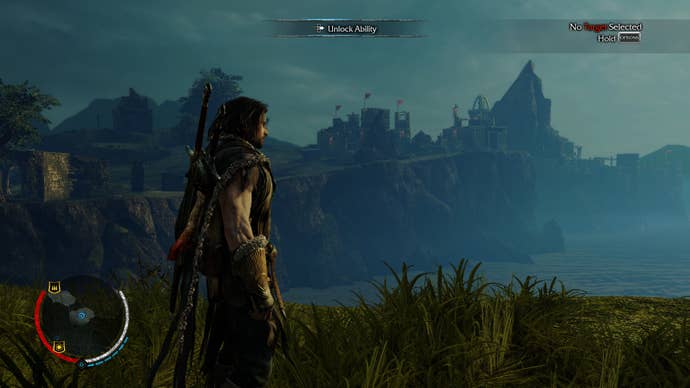
This review is based on my time with the PlayStation 4 version of Shadow of Mordor. That's what Warner Bros sent my way, so that's what I played. The game is beautiful experience with great image quality (all of the shots in the review are native screenshots from my PS4). Shadow of Mordor on PS4 runs at what looks to be a native 1080p resolution and a locked 30 fps frame rate (via Digital Foundry). It's mostly consistent in the frame rate department, though things do dip occasionally. Draw-distance is decent and there wasn't much in the way of pop-in as Monolith has decided to use fog for things beyond Talion's view.
You can tell that Monolith spent a great deal of time on the Uruk, because they look great. They're detailed and expressive in all their procedurally-generated variations. Gollum also stand up as a great-looking and well-animated character. In contrast, the human characters just don't look as good, perhaps because there's less overall exaggeration in their features.
The other problem with Mordor's visual style is the world around Talion looks great, but there's no sense of place. There's a great visual change between the dead Udun and the thriving, green Nurn, but within those regions, most everything looks the same. In Udun, where you begin the game, I honestly couldn't tell you the difference between one fortress and the next. You'll travel from one detailed fortress to another, with only the targets changing. I do wish more could be done to differentiate areas, even though Monolith doesn't have the benefit of easily indentifable neighborhoods within the cities that populate other open-world games.
Shadow of Mordor is an amazing start for an open-world franchise. If this is Monolith's version of the first Assassin's Creed, then the sequel to this game may be awe-inspiring. Right now, Shadow of Mordor stands alongside some of the best in genre, even if there are some frustrating drawbacks. It's definitely worth your time and money.

VisualsThe PlayStation 4 version is a looker with great image quality. The Uruk you'll be fighting against for most of the game are detailed
SoundThe game's soundtrack is memorable and epic, like the Lord of the Rings films.
InterfaceThe tiered menu can get occasionally confusing when dealing with the map, Sauron's Army, and the rest of the game's options.
Lasting AppealThe main campaign should take around 25 to 30 hours, depending on your luck with the randomly-generated Uruk. Finishing the extra missions, challenges, and other quests will take you a long time.
ConclusionShadow of Mordor is a great first step into the open-world action-adventure genre for Monolith. It up-ends what's come before with the Nemesis System, which brings the player closer to the game with personalized foes. The game isn't perfect - resurrecting foes can be frustrating - but those issues won't hold you back from enjoying yourself.







